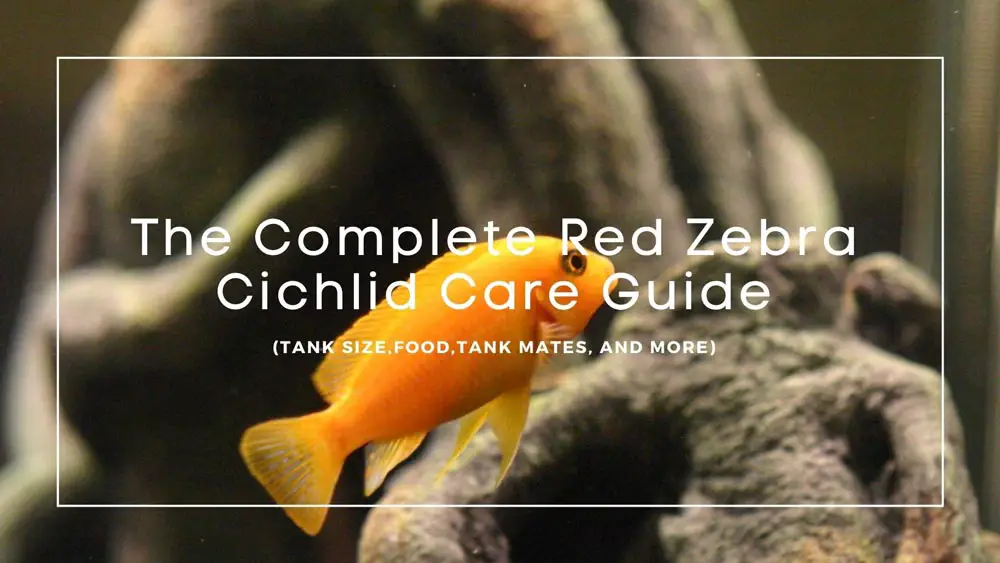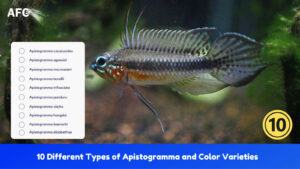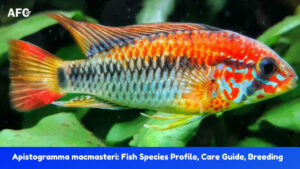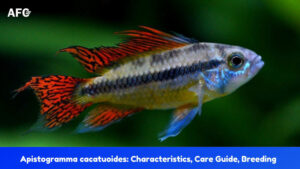Thanks to its bright colors and exuberant display, the Red Zebra Cichlid is one the most sought-after fish species.
It moves gracefully around the tank, with its slender body and long fins, further adding to its visual appeal. No wonder aquarists are looking to own several of these small fish to make their aquarium unique.
However, despite their size, these fish are aggressive and need a lot of attention to living a healthy life. Therefore, we’ve decided to provide a Red Zebra Cichlid care guide for your benefit so that you’re aware of the task at hand.
Typical Behavior
Like most African Cichlids, the Red Zebra variant is no different, known for its semi-aggressive nature. If you desire to keep docile and sociable fish in the tank, it would be best to avoid owning this species. Or you’ll need to place them in a separate tank.
While some fish are aggressive only during the mating season, Red Zebra Cichlid shows no lessening their ferocious behavior. Both the male and female fish have similar behavioral traits, so research before introducing them into home aquariums.
Are Red Zebra Cichlids Aggressive?
Red Zebra Cichlids are highly aggressive on account of their territorial nature. They react violently towards other species as well as their own, meaning they are not friendly.
Moreover, Red Zebra Cichlids have a matriarchal family, so the female is hard to befriend, especially when she is about to lay eggs. You can find them prowling around the tank, protecting their territory.
How Long Do Red Zebra Cichlids Live?
Depending upon the tank conditions, feeding habits, and how many fish you’re keeping in the aquarium, Red Zebra Cichlids can live up to a decade. However, in some cases, they may live shorter lives of 5 years, so their lifespan usually varies between five and ten years.
Another essential factor is to provide the right water conditions, as these fish are highly sensitive. Speaking of conditions, let’s discuss that next.
Natural Habitat And Tank Conditions
These fish are at home in the rocky waters of Lake Malawi in Africa, dotted with caves, so that they have enough room to hide. Like other Cichlids, they search for food on the lake’s sandy surface and in crevasses, scooping up tiny meals.
As they are at home in a rocky environment with no vegetation, you need not add plants to the tank. Red Zebra Cichlids are nibblers and tend to uproot plants, artificial or real, and may not do well in unfamiliar habitats.
Moreover, it’s essential to maintain the water conditions between 7.8 and 8.6 pH by adding an appropriate sandy substrate.
What Size Aquarium Do They Need?
They don’t grow bigger than five inches, meaning these fish don’t need a lot of space. However, it would help if you kept them in a 50-gallon tank at the very least to account for their territorial behavior.
Usually, a 50-gallon tank will hold around 208 liters of water, ensuring that there’s enough room for the fish to swim around. Also, don’t keep too many fish in one tank, as it may stress them out and promote violent behavior.
Appearance
Just like other African Cichlids, Red Zebra Cichlids are extremely attractive and change colors throughout their lives. That’s why they have different names based on their appearance.
They are primarily yellow but may also develop a blue or red coat in the wild. However, they don’t have stripes on their body, so the solid coloration makes them stand apart in the tank.
Now, some varieties may have a thicker body, accompanied by a slightly larger forehead and a long tail fin. Moreover, both the anal and dorsal fins are elongated and have yellow egg spots.
Red Zebra Cichlid Male Vs. Female
Although there’s not much difference between male and female Red Zebra Cichlids, there are a few stand-out features. For example, the male fish has larger egg spots than the female, assuming bright red colors in the wild.
Also, males are more territorial and aggressive towards other fish.
How Big Do Red Zebra Cichlids Get?
Red Zebra Cichlids are small fish that don’t grow bigger than 5 inches. In the wild, these fish are even smaller and reach a maximum length of 4 inches.
That said, you should get a 50-gallon aquarium to house them, ensuring that they can go about their daily activities without any difficulty.
Foods And Feeding
Red Zebra Cichlids are omnivores and feed on both meat and plants as part of their diet. As mentioned, they like to graze among rocks and crevasses and will dig up the sandy floor in search of tasty morsels.
In the wild, they feed on algae, zooplankton, and benthic invertebrates. So, you can infuse their diet with small amounts of vitamins and proteins to keep them healthy.
Now, don’t provide them with one large morsel because they gain weight very quickly. Red Zebra Cichlids can devour a meal in under three minutes, and before you know it, they will be overweight.
Hence, aquarists should offer them several smaller meals throughout the day, which will also keep the tank water clean.
What Do Red Zebra Cichlids Eat?
In aquariums, you can feed them a vegetable-based diet without any difficulty. Be it lettuce, flakes, pellets, spinach, or even duckweed; Red Zebra Cichlids have no problem eating an assortment of items.
Moreover, to replicate their natural habitat, it would be best to let algae grow inside the tank. This saves you the cost of buying regular fish meals while ensuring that they don’t starve.
The fish can graze on the algae when needed, making it easy to keep them healthy. Furthermore, you can feed them protein supplements like shrimp bits and succulent earthworms, just not a lot.
It’s important to note that these fish will eat anything, but a healthy diet is a must if you want to maintain their bright colors. So, try to base their diet around premium-quality herbivorous food, combined with tiny meat bits.
Tank Mates
Choosing a suitable tank mate is quite a headache because it’s challenging to judge how the Red Zebra Cichlid will react towards another species.
You can choose another African fish from Lake Malawi, the Jewel Cichlid, which might be able to keep up with their temperamental counterparts. In some cases, docile fish like bristlenose plecos, cuckoo catfish, and pop-eyed fish may also be suitable tank inhabitants.
Ideally, it would be best to keep the Cichlids in a separate tank. But as most aquarists like to mix species, try to ensure that the tank isn’t crowded.
Plus, they are aggressive towards each other, especially during the mating season, so it would be best to keep one male and several females.
Red Zebra Cichlid Breeding
A ratio of one male for every three females is the best way to breed homegrown Red Zebra Cichlids.
During the mating season, the male puts on an elaborate show for the female by shimmying and displaying its beautiful colors. And remember how we spoke about adding caves and rocks to the tank? Apart from hiding, it’s the perfect spot for the female to lay her eggs.
One female can lay up to 60 eggs, after which she puts them in her mouth and starts following the male. This is where the bright egg spots on the male help attract the female.
When she comes close, he releases the sperm to fertilize the eggs. Then the male and female go their separate ways, with the female taking sole responsibility for the eggs till they hatch.
All in all, it takes about 20 days for the fry to appear.
Red Zebra Cichlid Diseases
Red Zebra Cichlids are susceptible to several diseases; we’ve listed the most common ones below.
Swim Bladder Disease
Swim bladder disease prevents Red Zebra Cichlids from swimming, attacking the abdominal sac. There could be several causes for this disease, including trauma and physical injury.
Malawi Bloat
Malawi bloat is a common ailment among African Cichlids, affecting the kidney and liver. Some common symptoms include rapid breathing, swelling, discolored feces, and appetite loss.
Tuberculosis
Tuberculosis is highly contagious and may also spread to aquarists. It would help if you were watchful for lethargic fish, those exhibiting mood swings, and frayed fins, which are some tell-tale signs.
Conclusion
Although it’s a daunting task, your Red Zebra Cichlids will grow and flourish with the proper care and regular maintenance.
It would help to keep them in a large tank that resembles their natural habitat as close as possible. Adding rocks, pebbles, caves, and pyramids will offer them enough room to move around.
Additionally, you can keep the female in a separate tank during the breeding season, ensuring that the fry has enough room after hatching.
That’s all for now. I hope these tips prove useful to you! Anyone else have strategies for caring Red Zebra Cichlid, Comment them below!





